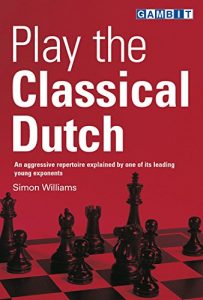“Reading this book one can see that there is sufficient variety inside the Dutch to have it one’s primary weapon versus 1 d4 throughout their career. Recommended” - IM John Donaldson, USA Team Captain
The Classical Dutch is a flexible opening that often gives Black dynamic attacking chances. In this book, one of its most enthusiastic adherents explains the workings of his favourite opening, and provides Black with a complete repertoire against 1 d4.
Few opponents will be ready to take on the Classical Dutch, since it has received little attention in chess literature in recent decades. For an opening that has been played by all-time greats such as Korchnoi, Tal and Larsen, the Classical Dutch’s current lack of popularity is puzzling. In this book, Simon Williams shows how Black can obtain counterchances against each of White’s main options. He also provides recommendations against all of White’s alternative approaches against the Dutch, including a variety of sharp possibilities after 1 d4 f5.
“The author makes a spirited plea for the Dutch. Its key ideas and theory are relatively clear and self-contained, providing a rare opportunity these days to absorb sufficient information to play and experiment confidently without considerable research.” - IM Craig Pritchett, The Herald
English grandmaster Simon Williams has gained a reputation for playing daring attacking chess. He represented England in World and European Championships in various age groups, and has been a regular in the British Championship since his early teens.
“Williams is not afraid to present his own analysis and to offer unorthodox assessments of some of the positions reached. ... Verdict: If you are interested in taking up an aggressive and still relatively uncharted response to 1.d4, this book would be a good place to start. If you already play the Classical Dutch, this book is a must.” - Phil Adams
“This is a decent book to begin learning the Dutch in some detail. You will find a lot of useful comment and ideas to use in your own games. Williams sets out to write a book for players of all standards, it is certainly an instructive example for players to learn good ideas from.” - Michael Blake, IECG
The Classical Dutch is a flexible opening that often gives Black dynamic attacking chances. In this book, one of its most enthusiastic adherents explains the workings of his favourite opening, and provides Black with a complete repertoire against 1 d4.
Few opponents will be ready to take on the Classical Dutch, since it has received little attention in chess literature in recent decades. For an opening that has been played by all-time greats such as Korchnoi, Tal and Larsen, the Classical Dutch’s current lack of popularity is puzzling. In this book, Simon Williams shows how Black can obtain counterchances against each of White’s main options. He also provides recommendations against all of White’s alternative approaches against the Dutch, including a variety of sharp possibilities after 1 d4 f5.
“The author makes a spirited plea for the Dutch. Its key ideas and theory are relatively clear and self-contained, providing a rare opportunity these days to absorb sufficient information to play and experiment confidently without considerable research.” - IM Craig Pritchett, The Herald
English grandmaster Simon Williams has gained a reputation for playing daring attacking chess. He represented England in World and European Championships in various age groups, and has been a regular in the British Championship since his early teens.
“Williams is not afraid to present his own analysis and to offer unorthodox assessments of some of the positions reached. ... Verdict: If you are interested in taking up an aggressive and still relatively uncharted response to 1.d4, this book would be a good place to start. If you already play the Classical Dutch, this book is a must.” - Phil Adams
“This is a decent book to begin learning the Dutch in some detail. You will find a lot of useful comment and ideas to use in your own games. Williams sets out to write a book for players of all standards, it is certainly an instructive example for players to learn good ideas from.” - Michael Blake, IECG



